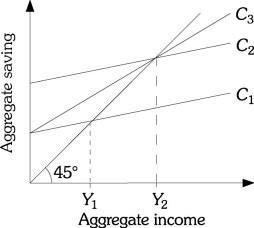Explain how an economy which is presently above its balanced growth path will converge back to its balanced growth path?
What will be an ideal response?
If an economy is presently above its balanced growth path, its capital-labor ratio is greater than the steady-state capital-labor ratio. In this case, growth from convergence will be negative, so the growth rate for the economy will be less than the balanced growth rate. The slower growth rate for the economy will eventually bring the economy back to its balanced growth path.
You might also like to view...
The table below shows data for Brazil
2006 2007 Real GDP growth rate 3.8 5.4 Inflation rate 4.2 3.7 Assuming the rate of velocity change is constant A) the growth rate of money increased between 2006 and 2007. B) the money growth rate was -0.4 percent in 2006. C) the growth rate of nominal GDP was 1.7 percent in 2006. D) the demand for money curve shifted leftward in 2006.
Plastics manufacturers can make either toys or plastic containers. If the prices and profitability of plastic toys increase, then the:
A. Demand for plastic containers will decrease B. Supply of plastic containers will increase C. Demand for plastic containers will increase D. Supply of plastic containers will decrease
The theory of public choice suggests that
A. you can lower your tax bill if you are careful not to consume too many government resources, regardless of what your neighbors do. B. government agencies tend to be inefficient because they are subject to institutional arrangements in which managers do not have an incentive to be efficient. C. government agencies tend to be inefficient because the people running them do not understand the concept of opportunity cost. D. the goods provided by government, whether public or private goods, are not scarce.
Refer to the information provided in Figure 23.4 below to answer the question(s) that follow. Figure 23.4Refer to Figure 23.4. If income is Y2
Figure 23.4Refer to Figure 23.4. If income is Y2
A. the society's savings is negative along C1. B. the society's saving is negative along C1, C2, and C3. C. the society's saving is positive along C2 and C3. D. the society's consumption is equal along C2 and C3.